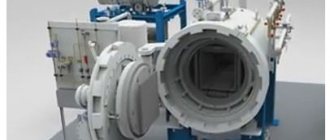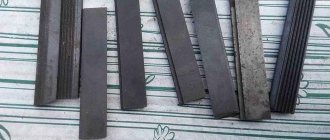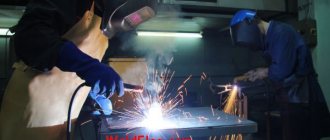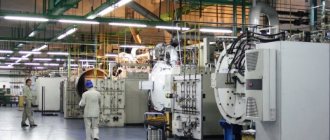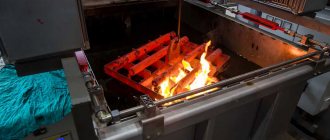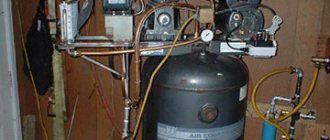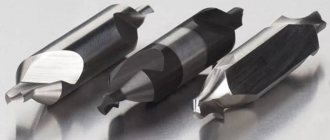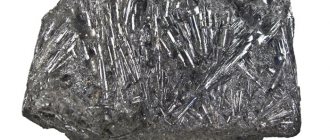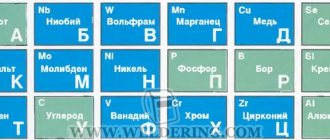Drill steel grades - which ones are better?
Nowadays, buying a high-quality metal drill is a real problem; most drills are Chinese, their quality leaves much to be desired. The quality of a drill depends, first of all, on the grade of steel from which the drill is made.
Most modern metal drills are made from R6M5 steel, although the difference between modern drills and drills from the USSR (with a quality mark) is simply huge, Chinese drills instantly roll up and it is impossible to drill even an ordinary corner made of 3mm iron with them. One drill is enough for several holes. However, there are also high-quality drills that last a long time.
Let's look at the steel grades, because the quality and durability of the drill depends on this.
P18 is now a legendary steel. Containing 18 percent tungsten, this steel supports metal processing even at high speeds. Drills made of P18 steel do not overheat, endure for a long time and drill well. True, finding the real ones is a whole problem. In Soviet times, r18 steel was used very widely for the manufacture of metal-cutting tools, but after the 70s, tungsten reserves were depleted and it was replaced by steel with a lower tungsten content - r6m5.
R6M5 - 6 percent tungsten, 5 percent molybdenum. Standard steel for metal-cutting tools. If the drill for metal is a Soviet one made from R6M5, then it is perfect for everyday use at home; such drills last for a long time, although they cannot drill through more hardened iron. The following drills with the addition of cobalt are suitable for this.
R6M5K5 is the same as R6M5, only 5 percent cobalt is added, which makes these drills even stronger and more durable. Cobalt drills are suitable for drilling where high temperatures are generated during drilling. Photo:
Excellent for drilling stainless steel and other hardened steels. In general, if ordinary drills do not take iron, then buy one with cobalt, you will feel the difference.
HSS is a foreign analogue of high-speed steel, translated as High Speed Steel, that is, steel for working at high speeds. HSS drills are similar in composition to the standard P6M5 high-speed cutter.
By the way, hss also comes with the addition of cobalt; drills are marked HSS-Co. Drills with this marking will be identical to our R6M5K5. Drills with cobalt - for drilling stainless steel and other durable steels.
It is also worth mentioning specialized drills for porcelain tiles, they are soldered and also come with crowns, if you are looking for information, follow the link, I prepared an article at the request of workers.
In general, if you decide to buy high-quality drills for your home, then I would recommend first asking around for drills from the USSR era; if they have a quality mark on them, then this is generally better than that. Soviet ones are inexpensive, you can even look at flea markets, you can probably find something there too.
Sovdepov drills are an excellent tool. If you take imported ones, then they cost a lot, for example, 6 mm HSS-Co drills cost around 70-80 rubles, while a similar Soviet one can be bought for 20-30 rubles.
Source
R18 or R6M5 which is better
High speed steels
- alloy steels, intended mainly for the manufacture of metal-cutting tools operating at high cutting speeds.
High-speed steel must have high fracture resistance, hardness (in cold and hot states) and red resistance.
Carbon tool steels also have high fracture resistance and cold hardness. However, tools made from them are not able to provide high-speed cutting conditions. Alloying high-speed steels with tungsten, molybdenum, vanadium and cobalt ensures hot hardness and red-hardness of the steel.
Creation stories [edit | edit code]
For turning parts made of wood, non-ferrous metals, and mild steel, cutters made of ordinary hard steel were quite suitable, but when processing steel parts, the cutter quickly heated up, soon wore out, and the part could not be turned at a speed of more than 5 m/min [1].
This barrier was overcome after R. Muschette produced steel containing 1.85% carbon, 9% tungsten and 2.5% manganese in 1858. Ten years later, Muschette made a new steel, called self-heating steel. It contained 2.15% carbon, 0.38% manganese, 5.44% tungsten and 0.4% chromium. Three years later, production of muschette steel began at Samuel Osburn's Sheffield plant. It did not lose its cutting ability when heated to 300 °C and made it possible to increase the metal cutting speed by one and a half times - 7.5 m/min.
Forty years later, high-speed steel from American engineers Taylor and Watt appeared on the market. Cutters made of this steel allowed cutting speeds of up to 18 m/min. This steel became the prototype of modern high-speed steel R18.
Another 5-6 years later, ultra-high-speed steel appeared, allowing cutting speeds of up to 35 m/min. Thus, thanks to tungsten, a sevenfold increase in cutting speed was achieved over 50 years and, consequently, the productivity of metal-cutting machines increased by the same amount.
Further successful use of tungsten found application in the creation of hard alloys, which consist of tungsten, chromium, and cobalt. Alloys for cutters such as stellite were created. The first stellite made it possible to increase the cutting speed to 45 m/min at a temperature of 700–750 °C. The alloy of this type, released by Krupp in 1927, had a Mohs hardness of 9.7-9.9 (the hardness of diamond is 10).
In the 1970s, due to a shortage of tungsten, high-speed steel grade R18 was almost universally replaced by steel grade R6M5 (the so-called “samokal”, self-hardening steel), which, in turn, was replaced by tungsten-free R0M5F1 and R0M2F3.
Classification of material and application of grade P12
Brand: P12 Material classification: High-speed tool steel Application: for all types of cutting tools when processing carbon alloy structural steels
Chemical composition of P12 material as a percentage
| C | Si | Mn | Ni | S | P | Cr | Mo | W | V | Co |
| 0.8 — 0.9 | up to 0.5 | up to 0.5 | up to 0.4 | up to 0.03 | up to 0.03 | 3.1 — 3.6 | up to 1 | 12 — 13 | 1.5 — 1.9 | up to 0.5 |
Other brands in this category:
Please note that this information about the P12 brand is provided for informational purposes. The parameters, properties and composition of real P12 grade material may differ from the values given on this page. More detailed information about the P12 grade can be found on the information resource Brand of steel and alloys. You can check with our managers for information about the availability, delivery times and cost of materials. If you find inaccuracies in the description of materials or errors found, please inform the site administrators using the feedback form. Thanks in advance for your cooperation!
Source
Characteristics of high-speed steels [edit | edit code]
Hot hardness [ edit | edit code]
At normal temperatures, the hardness of carbon steel is even slightly higher than the hardness of high-speed steel. However, during operation of the cutting tool, intense heat is generated. In this case, up to 80% of the released heat is spent on heating the instrument. Due to an increase in the temperature of the cutting edge, the tool material begins to temper and its hardness decreases.
After heating to 200 °C, the hardness of carbon steel begins to rapidly decrease. For this steel, a cutting mode in which the tool would heat up above 200 °C is unacceptable. High-speed steel retains its high hardness when heated to 500–600 °C. High speed steel tools are more productive than carbon steel tools.
Marking of high-speed steels [edit | edit code]
In Soviet and Russian steel grade books, high-speed steel grades usually have a special designation system and begin with the letter “P” (rapid - fast). This is due to the fact that these steels were invented in England, where such steel was called “rapid steel”. The number after the letter “P” indicates the average tungsten content in it (as a percentage of the total mass, the letter B is omitted). Then the content of molybdenum, vanadium and cobalt is indicated after the letters M, F and K. Foreign-made high-speed steel tools are usually marked with the abbreviation HSS (High Speed Steel), as well as HSSE (cobalt steel).
Designations
| Name | Meaning |
| Designation GOST Cyrillic | R12F2K5M3 |
| Designation GOST Latin | P12F2K5M3 |
| Translit | R12F2K5M3 |
| By chemical elements | — |
| Name | Meaning |
| Designation GOST Cyrillic | EP863 |
| Designation GOST Latin | EP863 |
| Translit | EhP863 |
| By chemical elements | — |
Application [ edit | edit code ]
In recent decades, the use of high-speed steel has been declining due to the widespread use of hard alloys. High-speed steel is used mainly for making end tools (taps, drills, cutters of small diameters). In turning, cutters with replaceable and brazed carbide inserts have almost completely replaced cutters made of high-speed steel.
There are the following recommendations for the use of domestic grades of high-speed steels.
- P9 steel is recommended for the manufacture of tools of simple shapes that do not require a large amount of grinding, for processing common structural materials. (cutters, cutters, countersinks).
- For shaped and complex tools (for cutting threads and teeth), for which the main requirement is high wear resistance, it is recommended to use P18 (tungsten) steel.
- Cobalt high-speed steels (R9K5, R9K10) are used for processing parts made of difficult-to-machine corrosion-resistant and heat-resistant steels and alloys, under conditions of intermittent cutting, vibration, and insufficient cooling.
- Vanadium high-speed steels (R9F5, R14F4) are recommended for the manufacture of tools for finishing (broaches, reamers, shaver). They can be used for processing difficult-to-cut materials when cutting chips with a small cross-section.
- Tungsten-molybdenum steels (R9M4, R6M3) are used for tools operating in roughing conditions, as well as for the manufacture of broaches, cutters, shaver, and milling cutters.
The density of the metal is so high that special tools and mechanisms must be used to process it. In order to make a hole in this material, drills and drilling machines are used, in which drills are the main cutting element.
Which metal drills are better? It is not easy to determine, because there are no universal products that would be suitable for processing all types of metal products. An experienced craftsman will be able to “by eye” determine the type of metal and quickly select the appropriate cutting tool for processing.
A beginner in this business needs to start with the basics. First, study the classification of drills and their scope of application, because the best models are products that are ideal for processing a specific type of metal.
What kind of drills there are, how to choose a suitable product for the job based on markings and appearance, find out in the article.
Types of drills for metal
To choose the best models, you need to understand the types of drills.
Spiral
Classic, cylindrical drills that are most often used for drilling metals. Typically, spiral products are made of HSS steel.
The material is a high-quality cutting type of steel, so the gimlets made from it are highly durable and durable.
Conical (stepped)
The cutting surface has the shape of a cone, which is why this type of drill got its name. Conical drills are used to make holes in thin metal, as well as to correct defects from other cutting tools.
What are the best step drills to choose? Depends on the type of metal being processed. If the density of the workpiece is too high, then it is better to purchase more expensive, golden-colored products.
In everyday life, this type of drill is rarely used. If you need to frequently drill thin metal sheets or process soft materials, then despite the relatively high cost, it should be purchased for your home workshop.
Core cutters (annular cutters)
The cutting tool is a cylinder with a cutting edge, which is used to cut metal.
The energy consumption for making a hole in this way is several times lower, due to the small contact area of the tool with the surface being processed.
The advantage of using this type of drill over others is the production of large diameter holes. In this case, it is possible to obtain better quality edges than when working with spiral models.
Feathers
A special type of flat gimlet with replaceable working edges is used for drilling metal. Such products allow you to make high-quality, perfectly straight holes.
The absence of distortion during the drilling process and the ability to make a large-diameter hole in various metal structures allows many craftsmen to abandon the use of spiral products.
The low cost of feather drills allows in many cases of metal processing to call them the best for drilling holes.
These are the main types of drills used for making holes in metal structures.
pros
High speed steel is a material used to make sharp steel tools. The composition of p12 is of high quality compared to conventional material. In addition, it has the most important property - wear resistance, because under the influence of friction, steel heats up and, accordingly, deteriorates over time. Today, manufacturers add compounds to high-speed alloys for strength to avoid heating.
When making knives, p12 steel has a consistency similar to powder, to which carbides are added. Due to these components, the knives become very durable. The marking “p” indicates that the product is high-speed, and the number “12” indicates the percentage of tungsten in it.
The undoubted advantages of knives made from p12 steel include the high-speed cutting properties of the blade . The p12 alloy can be sanded well. List of advantages:
- Excellent cutting characteristics.
- Long lasting performance.
- High strength.
- Steel is not affected by maximum temperatures.
- The structure is homogeneous.
- Not subject to destruction under the influence of the environment.
- Easily processed by grinding.
- Profitability of high-speed material production.
Classification of drills by material of manufacture
Which metal drills are the best for drilling particularly strong alloys is quite simple to answer:
- To process such material, you should choose products that have a plate of increased hardness on the cutting edge. Such gimlets are the best for processing hard alloys.
- The price of such products is low due to the fact that the main body of the cutting tool is made of ordinary tool steel.
Drills made of metal alloyed with cobalt have good characteristics.
They can withstand increased mechanical loads and excessive heating of the working surface during operation. The cost of the products is high, but if it is necessary to make holes in a hard alloy, then cobalt analogues are the best for performing such work.
Titanium drills are not inferior in strength to cobalt drills, and when drilling alloy steels and non-ferrous alloys they show even better results.
When used correctly, titanium models retain their factory sharpness for a long time, which will allow you to perform a significantly larger volume of work.
Inexpensive metal drills are made from ordinary high-speed steel P9 and P18. The cutting tool copes with its function perfectly, but the working surface quickly becomes dull, especially when a certain temperature threshold is exceeded.
Specifics of the material and its general characteristics
The name P12 is not a simple set of letters, but a marking that contains some information about the alloy:
- “P” - all high-speed steels are marked with this letter, from the English name rapid (speed);
- 12 is the percentage of tungsten in the metal, which forms very hard chemical compounds - carbides, which sharply increase strength and red-hardness.
Quick cutters have long been used to create edged weapon blades, due to their following characteristics:
- good hot hardness, which characterizes what temperature steel can withstand without loss of performance;
- increased red resistance - indicates how long the alloy will withstand this temperature;
- Great resistance to wear and external loads.
As a result, knives made from P12 will have strong blades that can easily withstand severe mechanical stress without deforming the structure of the product.
High hardness is a characteristic feature of such cutting tools; this important property affects both the service life and the quality of the cut. Although such an alloy can withstand bending loads, its weak point is increased fragility, since the hard metal is susceptible to brittleness.
Marking of cutting products
Marking drills for metal is necessary to determine the type of steel from which the cutting tool is made. The product also indicates its diameter, accuracy class and manufacturer (country). Only spiral gimlets with a diameter of less than 2 mm are not marked.
In other cases, drill markings may have the following meanings:
- P9 - made of high-speed steel with a tungsten percentage of 9%.
- P9K15 - indicates the presence of cobalt in the high-speed steel in an amount of 15%.
- Р6М5К5 - indicates the presence of a complex composition of cutting steel containing tungsten, cobalt and molybdenum.
Imported products have the HSS designation, which can be used to determine the composition of the material from which the drill was made. The HSS drill, which will be explained below, is used with an additional letter, which determines the presence of alloying metal.
- HSS-E - contains cobalt. Used in processing metals of high viscosity.
- HSS-Tin - has titanium coating, which significantly increases the hardness of the working surface, and the temperature resistance of the material increases to +600 degrees.
- HSS-E VAP is a cutting tool used for processing stainless materials.
- HSS-4241 - designed for drilling aluminum.
- HSS-R - have maximum strength.
Chemical composition
In its original form, any steel is a compound of iron and carbon. In this form, it is highly susceptible to corrosion, quite soft, and completely unsuitable for creating a cutting tool. During production, various other elements are added to it, which, when interacting with it, make it possible to achieve the necessary qualities.
All the properties for which R12M quick cutter is so valued are the result of the interaction of alloying components that are included in the alloy during production. Among them are the following:
- Carbon – from 0.80 to 0.90%. With increasing carbon content, the hardness, strength and elasticity of steel increase, but ductility and impact resistance decrease, and machinability and weldability deteriorate.
- Chromium - from 3.1 to 3.6%. This is the cheapest and most common alloying element. It is able to slightly increase hardness, however, its main property is an increase in corrosion resistance. The higher its content in the alloy, the more resistant it is to rust (steel becomes completely stainless when the chromium content is more than 13%).
- Vanadium – 1.5 – 1.9%. It increases hardness and strength, grinds grain. It increases the density of the steel structure, as it is a good deoxidizer, but it is expensive and scarce.
- Tungsten – 12.0-13.0%. In such an alloy it is the main component. Together with iron, it forms new carbides, which significantly increase such important characteristics as strength and red-hardness. It helps eliminate brittleness during tempering. It has a fairly high cost.
- Molybdenum – up to 1.0%. Increases red resistance, has a positive effect on elasticity, resistance to corrosion and oxidation at high temperatures.
- Cobalt – 0.1%. Improves heat resistance, magnetic properties of steel and shock load tolerance.
- Nickel – up to 0.4%. Increases the strength of steel while maintaining high toughness, prevents grain growth when heated, reduces warping during hardening, increases corrosion resistance and hardenability. With a nickel content of 18-20%, the steel becomes non-magnetic, heat-resistant, heat-resistant and corrosion-resistant.
The P12 quick cutter is produced by the powder method, that is, after smelting, the metal is crushed and blown into the workpiece. At this stage, all alloying additives are added to it, after which everything is fused under high pressure into the finished product. This method is more economical compared to traditional casting or forging and allows for improved performance.
Quick cutter P12 is produced using the powder method.
Visual identification of drill type
By the appearance of the cutting gimlet, you can determine the type of material from which the products are made and thereby find out the mechanical strength of the sample. By color you can determine the composition and quality of workmanship.
Grey
Gray drills are made of metal that has not been subjected to any additional processing.
The quality of the tool, in this case, leaves much to be desired, but for one-time use such products are quite suitable.
Black
This color indicates that the tool was treated with superheated steam. During processing, the product acquires greater strength.
It perfectly tolerates numerous cycles of heating and cooling of the metal, and also maintains the sharpening of the working surface for a long time.
The price of black metal drills is not much higher than gray products, so if you have a choice, you should give preference to tools of this type when purchasing.
Dark golden
This color indicates that the cutting tool has been tempered. This type of processing significantly increases the mechanical strength of the product as a result of reducing internal stresses.
With a tempered drill, you can successfully process high-strength metals, so if you are drilling too hard alloys, it is recommended to purchase a similar model.
Bright golden
The bright golden color indicates that metal made with the addition of titanium was used in production.
Despite the high cost of such models, it is much more practical to purchase a high-quality drill than to use cheap cutting tools, which will need to be used in large quantities for complex work.
Thus, it is easy to determine the quality of products by appearance and decide which metal drills are best to buy.
Minuses
The main disadvantage of P12 is its increased fragility, which somewhat limits the use of this alloy.
This high-speed steel cannot be used to make products that are subject to high impact loads, that is, axes, throwing knives, machetes, etc.
In addition to increased fragility, the metal in question has other minor disadvantages, which are completely offset by its advantages:
- quite high cost of final products;
- the production process is technically complex and expensive;
- lower toughness compared to tool steels.
So, P12 steel occupies its own niche, despite increased competition. All this is ensured by its characteristics: excellent viscosity, long service life, strength, etc. Knives made of this material remain in their original form for a long time, but they can break due to their high fragility. Careful operation and careful maintenance are what will allow such products to serve their owner faithfully for a long time.
The downside of P12 is increased fragility.
Classification by size
To choose the best drill and not overpay, it is enough to know what length sizes these products are usually divided into. If drilling metal does not require making deep holes, then purchasing models that are too long will lead to cost overruns.
It is customary to classify drills by length as follows:
- Short, 20-131 mm long. Tool diameters are in the range of 0.3-20 mm.
- Elongated, length is 19-205 mm, and diameter is 0.3-20 mm.
- Long series with a diameter of 1-20 mm and a length of 56-254 mm.
When performing drilling work of various depths, you should select the tool that is most suitable for the specific task.
The best manufacturers
To purchase drills and be sure that the declared characteristics are completely true, you need to choose the right manufacturer.
Companies that value their reputation do not sell products of inadequate quality. Therefore, when choosing metal drills, you should give preference to manufacturers who have been on the market for a long time.
Among the newcomers, there may also be worthy producers. But in order to find out that a good quality product is on sale, you need to make a purchase, which often represents a “lottery”.
1. Bosch - products of the German company have long proven themselves only on the positive side. Despite the rather high price of the products, when purchasing Bosch drills, you can rest assured of excellent quality. It is convenient and profitable to purchase tools from this company as a set.
Whatever set of drills you take, each one will contain only the highest quality products that will last for many years, provided they are properly stored and used.
2. “Zubr” is a domestic manufacturer whose products are maximally optimized in terms of price-quality ratio. You can purchase the products of this company either in a single copy or in the form of a set. The latter option will significantly save money, despite the significant cost of the kit.
3. Soviet-made drills - this category of cutting tools can be classified as an “endangered species.” With due diligence, you can purchase a rarity that has unsurpassed technical characteristics.
Conclusion
Which metal drills are best to buy depends on many circumstances:
- If you need to drill several holes in very thin and soft metal, then just buy a cheap drill that will do the job.
- For professional use, it is not at all profitable to purchase cheap drills. Low-quality products can lead to defects and significant time costs for frequent replacement of low-quality cutting tools.
Phone in Moscow, [email protected]
Methods and methods of sharpening
Even high-speed steel P12 is subject to wear and dullness, despite its impressive strength properties. If we take into account the information about the use and properties of this alloy, then we can safely say that it will not be possible to sharpen them using grinding wheels from electrocorundum: the surface after such treatment still remains rough, and the cutting qualities do not improve.
The most correct option would be to take the knife to a specialized workshop for sharpening, which has CBN wheels at its disposal. Having such cars in your garage is an unaffordable luxury and simply not advisable.
You can, of course, try sharpening at home, but it’s worth considering: at a minimum, this will require diamond stones, the prices of which have been very high lately. In this case, processing will be carried out in 2 stages:
- First, use a stone with a large grain - the so-called coarse sharpening.
- Then use a fine-grain abrasive for final sanding.
It is better not to try to sharpen it in a garage, as there is a chance of damaging the tool beyond its original state.
